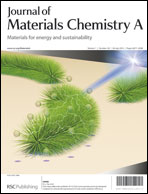In situ synthesis of high-performance 3D platinum (Pt) nanoflowers on porous silicon is achieved for the first time, which can be used as electrocatalysts for monolithic integrated micro direct methanol fuel cells (μDMFCs). A new mechanism to modify porous silicon has been developed that aims at changing its surface energy and creating an in situ reducing agent. 3D Pt nanoflowers are assembled in situ on the modified porous silicon surface through chemical reduction of a chloroplatinic acid precursor solution. Electrochemical results demonstrate that the as-prepared 3D Pt nanoflowers exhibit excellent electrocatalytic activity for methanol oxidation, achieving a maximum current density of 1.18 mA cm−2, which is enhanced to 1.82 times the value acquired on the commercial 20% Pt/C (0.65 mA cm−2). The main significance of this work is the in situ synthesis of 3D Pt nanoflowers on a fuel cell body without the extra coating process, which results in several advantages: (1) combining synthesis and coating of Pt nanocatalysts together, (2) simplifying the structure of fuel cells and making a monolithic integrated μDMFC possible, (3) enhancing the catalytic activity of Pt nanocatalysts for methanol oxidation. Hence, the proposed technique will be suitable for building a wide class of monolithic integrated micro fuel cells for system-on-chip.

You have access to this article
 Please wait while we load your content...
Something went wrong. Try again?
Please wait while we load your content...
Something went wrong. Try again?


 Please wait while we load your content...
Please wait while we load your content...